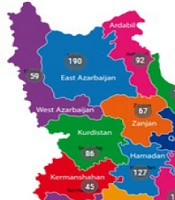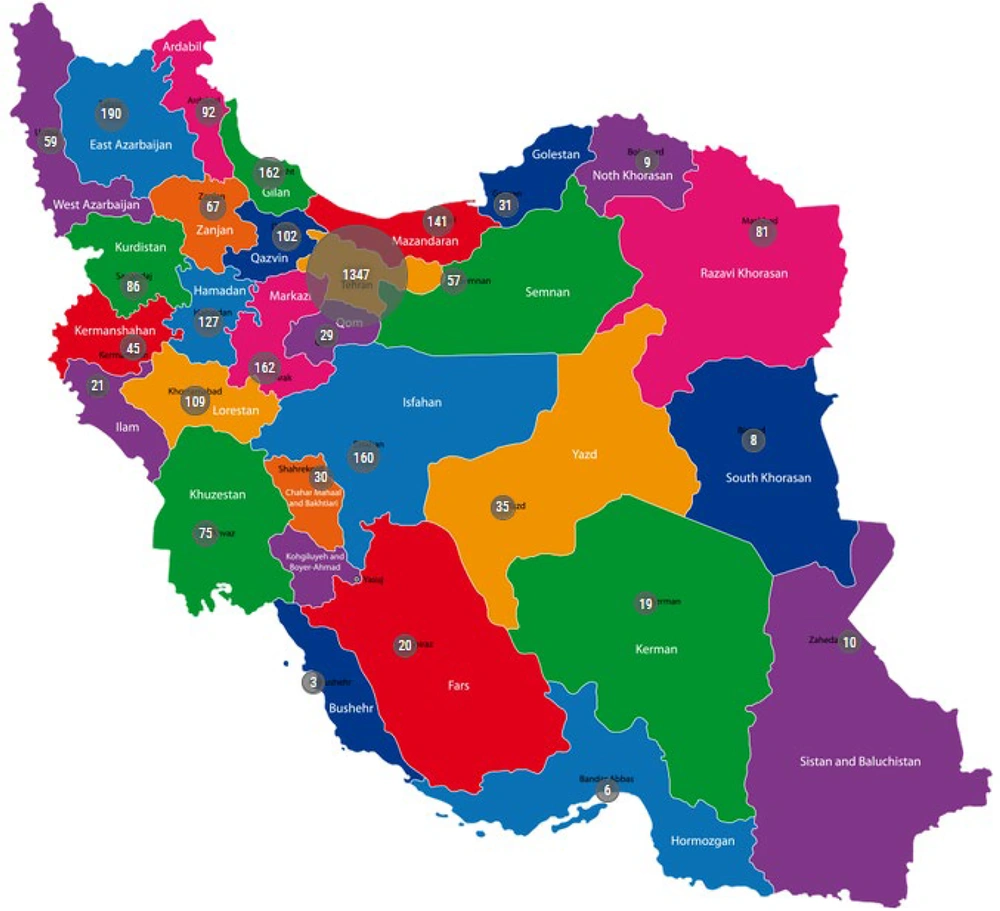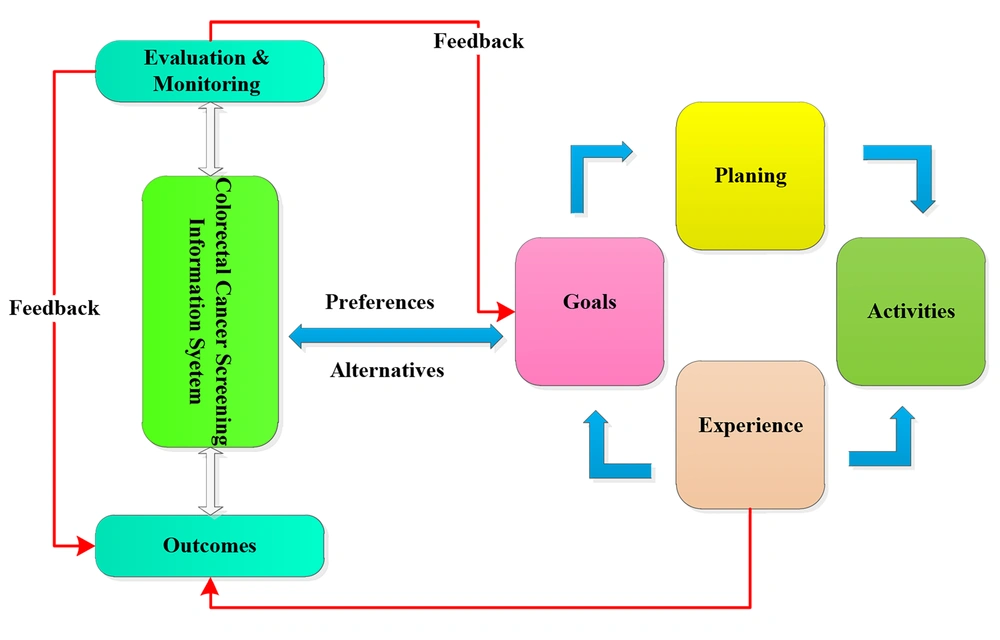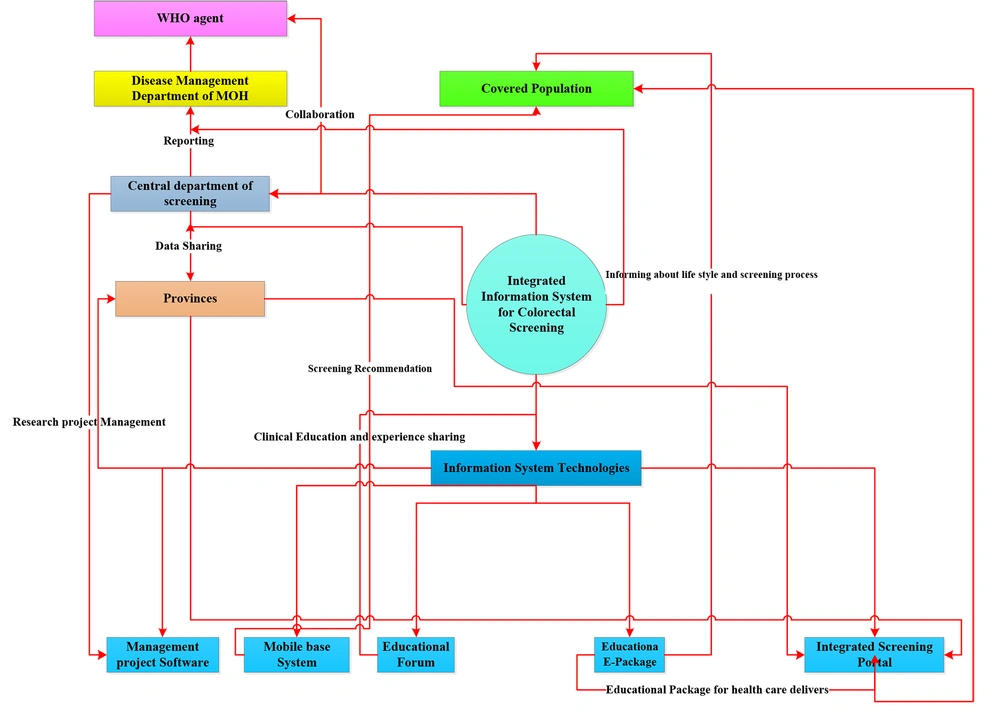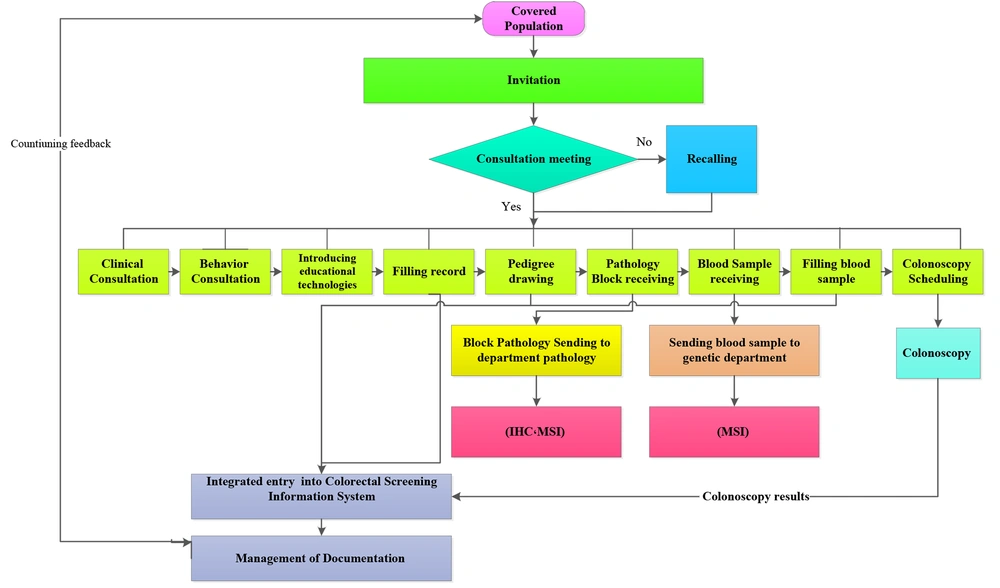1. Background
Colorectal cancer (CRC) is the third most prevalent cancers and the fourth leading cause of cancer mortality worldwide, accounting for 700,000 deaths with 1.4 million new cases in 2012 (1). According to the GLOBOCAN 2012 v1.0, the global burden of CRC is expected to increase by 60% to more than 2.2 million new colorectal cancer cases and 1.1 million deaths by 2030 (1). Incidence of CRC will double by 2030 in Iran (2). The economic burden of CRC in Iran was estimated US$298,148,718 in 2012. With regarding to high economic burden on the health care organizations and high mortality rate of colorectal cancer, policies should be approved to reduce the disease, prevention, and early diagnosis of CRC (3). Colorectal cancer incidence and mortality are reduced with regular screening (4). Integrated colorectal cancer screening process maximizes convenience, safety and satisfaction of patient and minimizes healthcare system costs (5). Therefore effective interventions in CRC screening plan are needed to support complex decision making (6).
In recent decades, decision making strategies for screening have become more complex (7). Current decision making strategies are untenable because complexity and the restriction human decision making (8). Clinical decision making for screening plan is a multi-stage process. This process involves collecting and analyzing a large volume of information for selecting of appropriate evidence-based interventions (9). A data driven cancer screening strategy based on personalized approach improves clinical efficacy and detects at risk population in early stages with cost effective methods (10). Completeness and quality of data is a very significant factor in cancer prevention system and efficiency of decision making process (11). In this study, data resources of information system based on CRC screening were analyzed.
Information systems (IS) facilitate systematic monitoring of cancer screening programs (12). An IS any combination of data, hardware, software, infrastructure and trained staffs to support planning, control, communication and decision making (12, 13). This technology increases the delivery of cancer prevention services and decreases interaction barriers of between health care providers and at risk individuals (13). Information systems can help the managers make more strategic and high accuracy decisions (14). One of the key success elements for countries depends on information systems to coordinate with business process. Also business process of screening plan should be adjusted to support information system in health care organization (15).
Business Process Reengineering (BPR) is dynamic analysis and redesign of workflow & core business processes within and between organizations. Business Process Reengineering can improve quality and reduce costs and cycle time especially in cross-functional team works. Also BPR optimize data dissemination and decision making by technology (16). Then there is a significant relationship between the decision support system and workflow re-engineering (17, 18). Decision support information systems improve re-engineering of business operations of organizations (18). A decision support systems (DSSs) includes an interactive software-based system and ancillary equipment that support decision making activities of work businesses and organizations (12). Decision support systems must be integrated into the cancer workflow to improve efficiency, eliminate mistakes (8). In this investigation, work process of CRC screening program with an emphasis on decision support information system was analyzed and redesigned. In this study, in the first stage, the status of the decision support system and information system of colorectal cancer screening was evaluated, and then the desired conceptual models were presented according to the experts' opinion.
2. Objectives
The aim of this study is to provide a conceptual model of an integrated decision support system for colorectal cancer screening.
3. Methods
The methodology used in this study is mix method research (MMR) which combines quantitative and qualitative methods. This present was conducted in Research Institute Gastroenterology and Liver Disease (RIGLD), Shahid Beheshti University in Iran. A program for colorectal cancer screening with new and comprehensive perspectives is being performing by RIGLD. RIGLD covered most provinces in Iran (Figure 1).
Covered patients in colorectal cancer screening program of RIGLD by provinces. This Map was extracted of MehrSys software. This software was used database of covered population in colorectal cancer screening for drawing of this map. MehrSys software is under copyright of RIGLD and also database belongs to this institute.
In the first step, present information system for screening was surveyed and information deficiencies and gaps were determined. A 128-item checklist was designed for assessing required components for information system of CRC screening. Items most frequently included in the checklist related to functions (6 items, 58 sub-items), technologies (12 items), data resource (21 items), users (16 items), manual and standards (21 items) of screening information system. The validity of checklist is measured by determining the validity of content, which is based on the reviews and the opinions of the experts related to information system of CRC screening.
A comprehensive search was conducted for checklist items used to assess the main dimensions of the CRC screening information system. In this step, all relevant books, articles, research projects, thesis, manual and scientific reports were extracted from MEDLINE, IEEE, Scholar, Web of Sciences, Scopus, Proquest, websites and databases related to colorectal cancer screening information system. Fifteen people evaluated the reliability and validity of the checklist.
The second step of study was qualitative survey. Interview and focus group discussion were conducted based on the views of 37 clinical decision makers and technical experts were worked in colorectal cancer screening plan. Participants were informed about cancer screening program and computerized decision support system. The researcher explained the purpose of the study and confidentially of information for participation. Also researcher asked for consent to audio-record the interviews. Researchers explained the study and obtained initial consent for further contact from participants. In-depth and semi-structured interviews used to study the reengineering strategies of CRC screening program by decision support information system. Interviewing involves asking questions and getting answers from participants. All interviews were fully transcribed and coded and analyzed by two researchers. The next step focus groups with semi-structured discussions were used to analysis and approve of final conceptual models and workflows.
4. Results
Finding of this article were presented two parts. The first part, general characteristics of CRC screening information system was described and next step, components of system was assessed. The second part, conceptual models and workflows were presented.
4.1. General Characteristics of CRC Screening Information System
General characteristics of CRC screening information system in four elements were described. Present information system did not have any of these elements. These general characteristics consist of the following elements:
4.2. Vision
Developing an integrated, effective screening system aimed at improving the quality of the colorectal cancer control program.
4.3. Mission
Collecting, processing, distributing and continuous managing of comprehensive, timely and accurate data related to the screening program.
4.4. Responsible Committee for Information System
The members of the committee including a representative of the department of pathology, oncology, gastroenterology, genetics, epidemiology and statistics and health information technology.
4.5. Situational Analysis of Colorectal cancer (CRC) Screening Information System
Colorectal cancer Screening information system was surveyed by approved checklist. In this study, current screening information system was surveyed of six dimensions. These dimensions were general specification, functions, technologies, data resources, users, manual and standards of screening information system. The present information system was performed only 24.6% of the expected system information tasks. The rate of using technologies, data sources, users, standards and standard of the current information system was 44.6%, 61.9%, 93.7%, and 38% respectively. Table 1 was illustrated situational analysis of CRC screening information system.
| Academic Fields | Values a |
|---|---|
| Epidemiology | 3 (8) |
| Genetics | 6 (16) |
| Biochemistry | 1 (3) |
| Molecular biology | 1 (3) |
| Pathology | 2 (5) |
| Oncology | 1 (3) |
| Gastroenterology | 5 (13) |
| General medicine | 4(11) |
| Anesthesiology | 1 (3) |
| Surgery | 1 (3) |
| Psychometrics | 1 (3) |
| Executive expert | 2 (5) |
| Software engineering | 3 (8) |
| Information technology engineering | 2 (5) |
| Statistics | 3 (8) |
Participants of by Academic Fields
4.6. Approved Conceptual Models and Workflows of Colorectal cancer (CRC) Screening Information System
We designed Conceptual models and workflows of CRC screening information system. The conceptual models were designed based on the business process management methodology (19). 37 clinical decision makers and technical experts in the multiple steps approved these models and workflows (Table 2). Figure 2 present relationship model between information system and CRC screening planning. According to relationship model, goals and plans are developed and monitored through CRC screening information systems. By views of expert panel, continues interaction was integral part of CRC screening planning and information system. Figure 3 illustrate conceptual model of integrated CRC information system. Integrated CRC information system utilizes information technology such as the portal, dashboards, educational forum, e- training packages, mobile-based system and project management software. Redesigned information system can covers the provincial units of the screening program, central unit, health non-communicable diseases management unit, representative of the World Health Organization (WHO) and the at risk people in Iran. In the flowchart of the screening program, all the processes from invitation of at risk people to genetic and pathology process was re-engineered (Figure 4).
| Item | Criteria | Present System a |
|---|---|---|
| Information System Activities | ||
| Clinical activities | Survival estimating, re-currency estimating, mortality estimating , risk factor estimating, incidence trend estimating, at risk population estimating, recommendation, planning, reminder option, risk classification, early detection, pedigree design, cancer grade analyzing, procedure analyzing, clinical & demographic analyzing of patient, sporadic CRC patient analyzing, analyzing of first and second degree relatives with FAP, analyzing of first and second degree relatives with HNPCC, colonoscopy report analyzing, Polyp analyzing, IHC analyzing, APC analyzing, MSI analyzing, monitoring of covered population | 5 (20.8) |
| Educational &learning activities | Electronic education to covered population, electronic education to covered population staffs, need assessment, internal education exchange, external education exchange | 1 (20) |
| Research & development/ evidence base medicine | Research progress reporting, research outcome reporting, need assessment, collaboration report for research, priorities and idea listing, database developing, research experience exchange reporting, research resource reporting | 2 (25) |
| Management activities | Decision making, daily- monthly-annual reporting, financial reporting, infrastructural reporting, tangible and intangible benefits analysis, burden of disease reporting, need assessment for strategic planning, operational planning, prioritization of services, reporting of cost-effectiveness of the screening program | 1 (10) |
| Executive activities | Reporting of telephone counseling, reporting of other counseling format, pathology block reporting, blood sample reporting, SWOT of executive activities, executive activity documentation | 2 (25) |
| General activities | News publishing, information exchange with related governmental and non-governmental organization | 1 (50) |
| Technologies | Portal, forum, E-package, screening network, mobile based system, management project software, evidence based website, decision support system, virtual colonoscopy, expert capsule for diagnosis, RFID for identifying of pathology block, dashboard for visual reporting | 5 (44.6) |
| Users | Ministry of Health (MOH), staffs of screening center, gastroenterology experts, staffs of genetic and clinical laboratory, researcher/ epidemiologists/ statistical expert, managers, patient, at risk populations, Deputy of Research of Ministry of Health, Medical Deputy of Ministry of Health, Research Institute, assurance company, colonoscopy center, oncologist, pathologists, psychologist, internal physician | 15 (93.7) |
| Data resources | Pathobiology center, mortality registry, Outpatient department, Radiology center, Hematology-Oncology center, Physician office, clinics, Unit of non-communicable diseases management, Health and Medical deputy of university, Immunohistochemistry center, Flow cytometry center, Ostomy association, Health information management of hospital, Deputies of ministry of health, Medical council of Iran, Health reference laboratory, Pharmacy, Red Crescent and pharmaceutical companies, Assurance company, Bioinformatics database, Website and portal related to CRC screening | 31 (61.9) |
| Manuals and standards | HIPAA, documentation standard, Amsterdam & revised bethesda guidelines, clinical guidelines, genetic guidelines, standards of clinical reporting, standards of screening workflow, information management manual and standard, Risk assessment guideline, Cancer registry standard, Nomenclatures of screening procedure, ATC, ICPC, SNOMED, LOINC, information exchange standard, DICOM, ICD-O, ISO standards, ISCO | 8 (38) |
Situational Analysis of CRC Screening Information System
5. Discussion
Information system can help for cost effective interventions of CRC screening and increase interaction between health care providers and patients (13). One of the most important clinical tasks of information system is risk assessment (20). However findings of study demonstrate limited clinical tasks were conducted in the present screening information system.
Shared decision-making based on technology increase awareness and can help at risk individuals for selecting informed options for prevention (21). Also computer-based decision system can increase quality of decision making beyond traditional and static strategies of CRC screening (22). Present screening information system in educational task focus only on traditional education for decision making of patients and health care providers. While information systems follow the educational and research objectives of health care organizations and increase productivity (23). These technologies can transform the traditional interaction between clinicians and patients into a more productive and structured relationship (24). The educational objectives of the existing system are limited to the population covered by the screening program and the e-training of health care providers were not carried out. The e-interaction of information between experts and needs assessment was not carried out.
Managers state more effective planning for a screening program can support with up-to-date and accurate information (24). The present information system is not capable of providing management reports, only limited to daily and routine reports.
Technologies used in the present screening information system were less than 50%. Present information system does not use any computerized technologies such E-forum, portal, dashboard, experience network and evidence based website. The web-based decision support tools, based on decision model such as analytic hierarchy process (AHP) facilitate colorectal cancer prevention processes (25). The technologies used in information systems enhance the system's ability to delivery services. One of the effective technologies in screening programs is decision support system; this technology does not used in present screening information system. While decision support systems via deep models can support ongoing cancer follow-up (26).
Today, concerning the high amount of information create in the CRC screening process, much time should be spent on retrieval of information. Standard tools such as classification and nomenclature system optimize the process of data retrieval of big and complex database (27). Also standards of information exchange such as health level 7 (HL7) facilitate interaction and improve quality of data (28). In the present system, limited standards were used. Considering the benefits of using standards, especially their role in integration and information exchange, compliance with standards and guidelines seems necessary. With regarding to the importance of information systems in improving the quality of cancer screening programs and deficiencies of existing screening information system, the effective factors and deficiency reasons must be identified and eliminated.
Wagholikar et al. CRC screening workflow significantly improved the performance of decision systems and increased quality of information (29). Accurate design of work process and integration of information increases the effectiveness of the screening program (24). In the present system, there were no standardized work processes and there was no interactive between the goals of the screening program and the current information system. Given this key role of standard work processes in increasing the effectiveness of the screening program; work processes of colorectal cancer screening based on decision support information system were re-engineered. Studies show that the reengineering of work processes and their correction in the standard format plays a significant role in availability of useful and complete information and increase productivity of decision-making system (29). Therefore, in this paper, we reengineer colorectal cancer screening program based on decision support information system. This is expected to increase the effectiveness of the screening program with accurate implementation of these standard work processes.
5.1. Conclusions
Recent reviews shows situational analysis of information system is essential option for comprehensive implementation of integrated colorectal cancer screening. It is evident that the use of these systems offers tremendous opportunities to increase the quality of care, to support health care providers and to allow quick and easy access to the heterogonous health information resources. Therefore one of the key aspects to achieve integrated system of colorectal cancer screening is situational analysis of information system. In this paper, colorectal cancer screening information system was analyzed by principle dimensions. The criteria included in CRC screening information system, a 128-item checklist, can help researchers to describe important aspects of information system related to CRC screening. With regarding to the importance of information systems in the managing of cancer screening programs and existing deficiencies of present screening information system, the effective factors related to deficiencies must be identified and eliminated.
Reengineering is a powerful & significant change strategy that can bring quality improvements in decision making processes of colorectal cancer screening plan. We reengineer cancer screening work process based on decision support information system after from situational analysis of information system. In this stage, interoperable contents identified and new work process by business process management methodology was developed. As a conclusion, it is recommended to support the successful implementation of reengineering plan; significant infrastructures such as educational, technical, cultural and financial infrastructures were analyzed.
